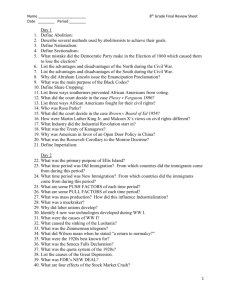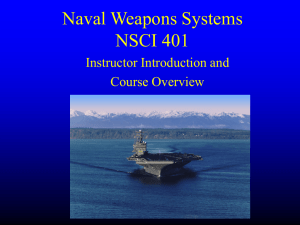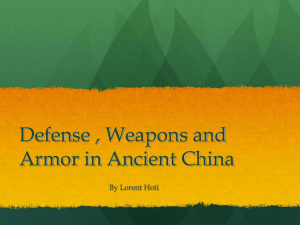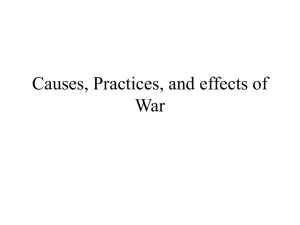Technology and War
advertisement
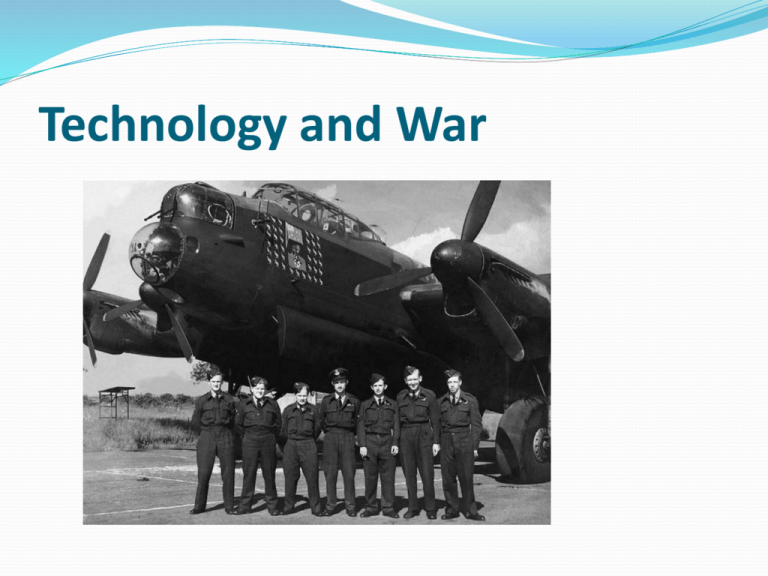
Technology and War European military power in the 19th and early 20th centuries (Curtin) Factors contributing to European militarization: • Mastery of production techniques to mass produce firearms. • Large numbers of officers ready to battle: Napoleonic and Crimean Wars (1853-1856). Wars were testing grounds for new technologies. • The railroad and the telegraph enabled the British to survive an uprising in India in 1857. • Advances in medical science meant that Europeans felt safer going abroad to tropical places • Firearms developments, such as repeating rifle, machine gun and lightweight artillery, gave Europeans an advantage, as they could defeat opponents with small military units • The machine gun was fully realized in World War I, where it eliminated the need for cavalry units and redefined infantry units • Improvements in the steam engines allowed for more space on steam ships to transport troops. • The newfound military strength was used to colonize Africa and Asia. European Military Advantage • Many countries were slow to adopt European innovations in arms technology, military organization, and naval warfare, • Reasons included lack of budgets, an industrial infrastructure, a logistical support system. Some lacked a socio-political system capable of supporting such endeavors. • Access to technology still is a factor in military advantage today – ie. access to nuclear weapons Technology and War (Martin Van Creveld) • Military technology has changed the conduct the war, but • • • • • does not affect the causes of armed conflict. The Military Industrial Complex has a vested interest in a bellicose atmosphere to sell it wares. The presence of those wares helps create such an atmosphere. Technology helps war, though people design, produce, and use technology for the realization of their ends. Over last 40 years, wars taking place below the nuclear threshold have two forms: 1) among countries without nuclear weapons or were not too tightly coupled to others that do and 2)sub-conventional type (insurgency, terrorism, guerilla warfare) Guerillas and terrorists are usually weak in numbers, organization , and technology at their disposal – prefer continuous harassment to direct clashes. They make do without heavy weapons and without a large, permanent logistical infrastructure. Weapons used by guerillas – not designed for that purpose initially. Only since the rise of the precision-built, factorymanufactured, crew-operated weapons in the 19th century – that one can speak of separate guerilla armory – which was lighter, smaller, and weaker versions of weapons used by regular forces. Guerilla Warfare Guerillas create a base area – where regulars are afraid to enter – and then they try to disrupt main arteries of communication through erection of physical barriers and ambushes. Outstanding problem –has been the inability of regular forces to operate and exist in economically underdeveloped areas. So regular forces were forced to split up into smaller units, leaving them tactically vulnerable and they had to do without heavy equipment (their principle advantage). • Victory by anti-guerilla forces depended on their ability to isolate the guerillas and pin them down. This could be done by erect a human or physical barrier around the affected region -> deny guerillas logistic support by destroying anything that could be of use to them ->carve the guerilla areas into smaller section -> use commandos to hunt guerillas. Guerilla Warfare Railways and telegraphs gave governments ability to send troops to previously inaccessible regions. Guerilla warfare shifted to more remote, technologically lessdeveloped areas (i.e. forests of Poland – attacked German-used roads, railroads, and communications) End of WWII, successful guerilla warfare stopped in Europe, but persisted in Asia, Africa, and parts of Central and South America. It was employed by national liberation movements. The USSR supplied hundreds of revolutionary movements. Challenge fighting guerillas in 3rd world: Major modern weapons are meant to fight machines not people. The weapons are dependent on electronic means for surveillance, reconnaissance, target acquisition, range finding, etc.. Can’t distinguish between friend or foe. Terrorism resembles guerilla warfare, concealment and anonymity counts for everything. One difference is that terrorists operate in crowded demographic centers. Terrorism’s goal: disrupt normal functioning by a prolonged series of operations and creating an atmosphere of uncertainty and fear. Terrorist’s weapons are limited, must be small, light, and easily hidden. Only in 20th century were high-powered, small devices available to terrorists – such as radio-controlled bombs and anti-tank missiles. Terrorists also take advantage of modern day communications technologies. Media helps them appear stronger than they might be.. War, Technology, and Innovation (Friedel) Late 18th century war-makers came to their Steam-Powered Warships capabilities, strengths and fates linked to novel weapons 19th century agents of change institutionalized: schools, arsenals, and shipyards became innovators, experimenters, and testers -> development of “military industrial complex” Warfare enlarged with mass production of weapons. The application of industrial technology increased the killing power of the military, accelerated the typical incremental improvements in weapons. Primary problem of military in 2nd half of 19th century was controlling the costs. 1812: 1st steam warship. British relied on it during the Crimean War – gave a big advantage over wind power. War, Technology, and Innovation (Friedel) Improvements in guns and armor Naval guns range and size grew with the addition of steel. The use of steel shells by the French led to the demise of wood and sail ships. In 1859, the French developed the first iron-clad warship, Britain followed suit. The spiral continued with gun powder and armor, and warships. U.S. and Japan joined the arms race. Late 1800s, submarines became more prominent . They were used extensively in World War I. Other technological improvements focused on the motors: diesel engines, high speed radial piston engines, aircraft engines, heavy duty truck and vehicular engines. Another technology, which was eventually banned, was poison gas. This was used in WWI, but banned thereafter. The ban stuck even through WWII. Technology and War Post-WWII (Boot) • The U.S. has become the undisputed master of the commons (sea, air, and space) that allows the U.S. to project its power anywhere in the world at short notice • IT is central to U.S. military dominance, as other factors remain the same (i.e. speed of U.S. navy destroyer has not changed in the past 100 years). Since the 1970s communications, targeting, surveillance, and ordnance technologies have become more potent and have given the U.S. the advantage in the commons. • On the other side, modern technology still leaves troops vulnerable to gangs/terrorists who employ car bombs, or portable WMDs. Infantry (Boot) • Armies still center around light infantry troops that are transported by vehicles, trucks, and aircrafts. • All modern tanks have the same military technologies: stabilized turrets, night-vision capabilities, laser range-finders, and targeting computers and most can be destroyed by other tanks, massive mines, aerial bombs, or artillery • • • • • • shells. Advances in anti-armor technology will be key to the infantry, i.e. attacks against Israeli tanks in Lebanon in 2006 by anti-tank rockets – the wave of the future. U.S. developing the Future Combat System: • lighter vehicles, manned and unmanned • stealth designs to make them harder to detect, • composite armor • hybrid-electric engines to lessen fuel needs. Still not good against guerillas and counter-insurgency missions. Infantry tools remain the same. Only body armor (kevlar) has improved. The proliferation of small arms equalized infantry worldwide. Night-vision devices, Global Positioning Systems, and shoulder-fired missiles – only real technology advances for infantry. However now, infantrymen can use wireless communications devices to support firing on specific coordinates. Warfare on the Seas (Boot) • Navy: no one tries to challenge the • • • • US navy. Few countries even have aircraft carriers, Russia and France each have one – a fraction of the size of the U.S. carriers. Britain has 3, but only helicopters can land on them. Many countries have anti-ballistic missiles to attack warships. Transport ships and fuel tankers have no defenses and are needed for refueling. Diesel submarines, which have ultra-quiet electric engines, are the new wave. Many countries have them: China, India, Iran, and Algeria (among others). They are very hard to track. Mines are another threat to ships. Aerial: • Modern surface-to-air missiles pose an immediate danger to the US • jammers, radar-seeking missiles, and decoys and stealth technology making planes virtually invisible – can neutralize air threats. • hand-carried missiles still a threat- which is why the U.S. relies heavily on drones and US. Fighter planes must stay 15,000 -20,000 feet high in high risk zones Space Warfare: • surveillance, communications, and intelligence done by unmanned aircrafts and satellites. • GPS though is now wide-spread.40 countries have their own satellites. • Satellites no longer needed as Google, DigitalGlobe, and Space Imaging sell or give away high-resolution satellite photos via the Internet. • Targets identified from space can be used by guerilla/terrorists groups or be hit by missile attacks. • Hence the U.S. is employing missile defense technology Aerial and Space Warfare (Boot) Robotic Warfare (Boot) • Unmanned Aerial Vehicles (employed by U.S. and Israelis) – were used in Iraq War in 2003. • Drones built especially for combat are the future. They will be invisible to radar and will have highly dangerous missions, such as suppressing enemy air defenses. • Nuclear-powered UAV are even further into the future • The Defense Advanced Research Projects Agency (DARPA) is researching really small UAVs, the size of an insect • Unmanned ground vehicles were used in Afghanistan and Iraq – mainly for reconnaissance. • What are the moral implications of the use of robots in military? Should we develop robots that are autonomous, machine can decide when/if to shoot? Limits of Technology Supremacy (Boot) • Simple countermeasures like camouflage, smoke, and decoys, by • • • • • bad weather, or by terrain – limits surveillance systems. Urban areas still present many challenges: more people and things to track and more obstacles (buildings, vehicles, signs, etc) Determining if someone is a civilian or combatant still challenging despite all the new technologies. Smart munitions is outstripping the protection afforded by speed or armor US ports, airfields, and bases are vulnerable. Safe, assured access to overseas bases are crucial for the US. Modern transportation and communications infrastructure allows fighters anywhere access to the US and to U.S. troops combat zones around the world.

